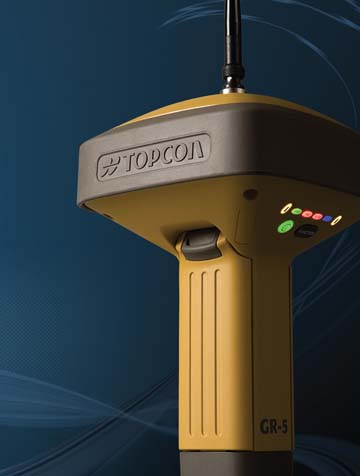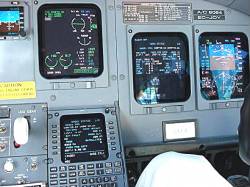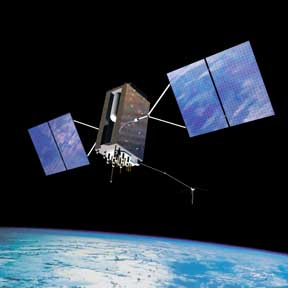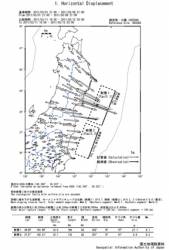TOPCON Launches GR-5 Integrated GNSS Receiver/Antenna
 TPS GR-5
TPS GR-5Topcon Positioning Systems (TPS) has launched its new GR-5 GNSS receiver using patented Fence Antenna technology and expanded tracking-channel support.
By Inside GNSS TPS GR-5
TPS GR-5Topcon Positioning Systems (TPS) has launched its new GR-5 GNSS receiver using patented Fence Antenna technology and expanded tracking-channel support.
By Inside GNSS Omnistar DGPS world map
Omnistar DGPS world mapTrimble announced on March 16 that it has entered into a definitive agreement to acquire certain assets related to the OmniSTAR GNSS signal corrections business from Fugro N.V.
The acquisition is expected to significantly expand Trimble’s worldwide ability to provide correction services for a broad range of land-based applications in addition to OmniSTAR’s current focus in agriculture. Fugro’s offshore marine business is unaffected.
By Inside GNSS EGNOS-equipped cockpit
EGNOS-equipped cockpitOn March 2, ESSP (the European Satellite Services Provider) declared the safety-of-life (SoL) signal from the European Geostationary Navigation Overlay Service (EGNOS) officially available for use by aviation, following European Commission (EC) authorization to provide the service.
Similar to the U.S. Federal Aviation (FAA) Administration’s Wide Area Augmentation System (WAAS), EGNOS transmits real-time corrections to GPS signals over a large expanse of Europe and north Africa.
By Inside GNSS GPS III satellite. Lockheed Martin illustration
GPS III satellite. Lockheed Martin illustrationLockheed Martin announced today (March 15, 2011) that the team it leads in developing the U.S. Air Force’s next-generation GPS III satellites has successfully completed the program’s first major flight-software integration milestone at the company’s software integration laboratory in Newtown, Pennsylvania.
By Inside GNSS
Based on data from Japan’s GPS Earth Observation Network System (GEONET), researchers at the Geospatial Information Authority of Japan (GSI) reported today (March 14, 2011) that the 9.0 magnitude Tohoku earthquake on March 11 in northeast Japan caused an estimated displacement of between roughly 6 and 28 meters along two fault blocks totaling nearly 400 kilometers (248 miles).
By Inside GNSS Figures 1 & 2
Figures 1 & 2For the complete story, including figures, graphs, and images, please download the PDF of the article, above.
Growing dependence on GNSS for positioning, navigation, and timing (PNT) has raised a parallel concern about the potential risks of signal interference. The popular press has recently highlighted accounts of car thieves using GPS jammers, solar flares pumping out L-band radiation, and faulty television sets causing havoc to GPS receivers across an entire harbor.
By Inside GNSSThe GPS community is seething over a January 26 decision by the Federal Communications Commission (FCC) giving a conditional go ahead to a new broadband network with the potential to overwhelm GPS receivers across the country.
By Dee Ann Divis
The International Committee on GNSS (ICG), is a voluntary United Nations–backed association that brings together GNSS and augmentation providers — including the United States, Russia, European Union, China, India, and Japan — and associate members representing key user communities.
By Inside GNSS A Coast Guard search and rescue helicopter demonstrates the use of GPS technology at a previous GPS Partnership Council meeting. (Photo: Joe Juarez)
A Coast Guard search and rescue helicopter demonstrates the use of GPS technology at a previous GPS Partnership Council meeting. (Photo: Joe Juarez)Registration is now open for the 2011 GPS Partnership Council meeting on Tuesday, May 3 and Wednesday, May 4 at the Space and Missile Systems Center (SMC) at Los Angeles Air Force Base in El Segundo, California.
These military and industry networking meetings, now in their 11th year, are sponsored by the Los Angeles chapter of AFCEA (Armed Forces Communications Electronics Association) and the USAF GPS Directorate, formerly the GPS Wing.
By Inside GNSS U.S. Capitol rotunda. Photo: Architect of the Capitol
U.S. Capitol rotunda. Photo: Architect of the CapitolSpace-Based PNT, National Executive Committee Public Release (March 14)
By Inside GNSS Fira de Barcelona, Monjuic venue
Fira de Barcelona, Monjuic venueThe GlobalGEO Fair will take place in the Monjuic Venue, Hall 6 at Fira de Barcelona exhibition center in Barcelona, Spain from March 15 to March 17.
The fair features the latest products for GPS navigation, 3D mapping, geographic information systems, photogrammetry, teledetection, geodesics, topography, satellite navigation, intelligent transport systems and communications.
By Inside GNSS
Aroused by the Federal Communication Commission’s (FCC’s) waiver of limits on ancillary terrestrial components (ATCs) for LightSquared’s proposed 40,000-transmitter network, representatives from a wide variety of industries and companies announced today (March 10, 2011) formation of the “Coalition to Save Our GPS.”
By Inside GNSS
Despite the fact that China’s rapidly developing global navigation satellite system now has seven spacecraft in orbit intermittently broadcasting test signals, it is the only GNSS provider that has not yet published a draft version of its interface control document (ICD), although one has reportedly been completed for more than a year.
Against that background, any new source of information about the directions of the Compass design — official, semi-official, or other — draws special attention.
By Inside GNSS